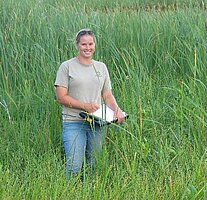Plant Species Composition of Wetlands Located in Restored Native Prairie
Breanna Paradeis is a M.S. student in the Natural Resources Management program at North Dakota State University. She graduated in December of 2005 from the University of Wisconsin-Madison with a B.S. in biology and biological aspects of conservation. As an undergraduate, Breanna developed a strong interest in ecology and restoration, especially pertaining to aquatic ecosystems. She is now studying prairie pothole wetlands located within restored prairie areas throughout North Dakota in order to determine their functionality and condition.
Email: Breanna.Paradeis@ndsu.edu
Fellow: Breanna Paradeis, School of Natural Resource Sciences, NDSU
Advisor: Dr. Don Kirby, Director, School of Natural Resource Sciences, NDSU
Matching Support: NDSU
Degree Progress: M.S. in Natural Resources Management expected in May 2008
Plant Species Composition of Wetlands Located in Restored Native Prairie
Wetlands are an important landscape feature in the Prairie Pothole Region (PPR) of the Northern Great Plains. Wetlands impart several benefits including the maintenance or improvement of water quality, groundwater recharge, flood attenuation and the provision of habitat and/or forage to wildlife and livestock (Kirby et. al 2002a,b). However, wetlands have been impacted in the Prairie Pothole Region by various human activities including agricultural practices. These impacts have lead to the decline of wetland functions and water quality (Detenbeck et. al 2002). Restoring species richness and diversity and managing native prairie wetland complexes in a way that mimics natural disturbance processes while minimizing negative human impacts will improve wetland functions and water quality.
In recent years, several large-scale restorations of native grasslands have occurred throughout the state of North Dakota. Many of these restorations, often on large tracts of publicly owned land such as National Wildlife Refuges, have focused on restoring native plant species diversity and richness in the surrounding prairie areas rather than within the wetlands themselves. However, it is likely that the wetlands have functionally benefited from the restoration and improved management of the surrounding uplands. Evaluation of the plant species composition of the restored wetland and upland areas and of the subsequent management regimes, will give insight towards the hydrological functions and processes occurring within these wetlands, i.e. water storage, improvement of water quality, and sedimentation.
Project Objectives:
The goal of this study is to evaluate plant community composition and physical characteristics of prairie pothole wetlands in restored native prairie areas and to incorporate the data obtained into a model that predicts wetland condition and function based on environmental variables. This study will also compare and evaluate restoration and management techniques employed in restored native prairie areas, and their effect on the plant species composition, physical characteristics, and functional capacity of wetland ecosystems.
Progress to Date:
Restored wetland study sites were selected based on restoration techniques and time since restoration. Native sites were selected based on distance from restored sites for comparative purposes. Wetland vegetation data was collected using an Index of Plant Community Integrity (IPCI) method for native and restored wetlands located throughout the Prairie Pothole Region. In the surrounding upland areas, vegetation data was collected along several transects placed at mid-slope and top-slope positions within the watershed.
The physical and functional characteristics of each wetland were evaluated using the Hydrogeomorphic (HGM) model as developed by the U.S. Corps of Engineers. The HGM model provides a means for direct comparison of the landscape and hydrological function of wetlands in different hydrologic regimes and diverse environmental conditions. Similarly, landscape information, i.e. upland land use, was obtained for each wetland and its surrounding catchment basin. Information and records pertaining to the restoration techniques employed were obtained (when available) for each wetland included in the study. Similarly, management records were obtained for both the native and restored wetlands.
Significance:
This project will assess the condition of wetland and upland plant communities in restored areas in order to relate the function of prairie pothole wetlands to environmental conditions. This project will also provide valuable insight on the functional capacity of restored wetlands in various states throughout the region in order to evaluate restoration attempts and management techniques. The results of this study could be used to help guide future management and restoration efforts in ways that further improve wetland functions.

Don Kirby
School of Natural Resource Sciences
NDSU



